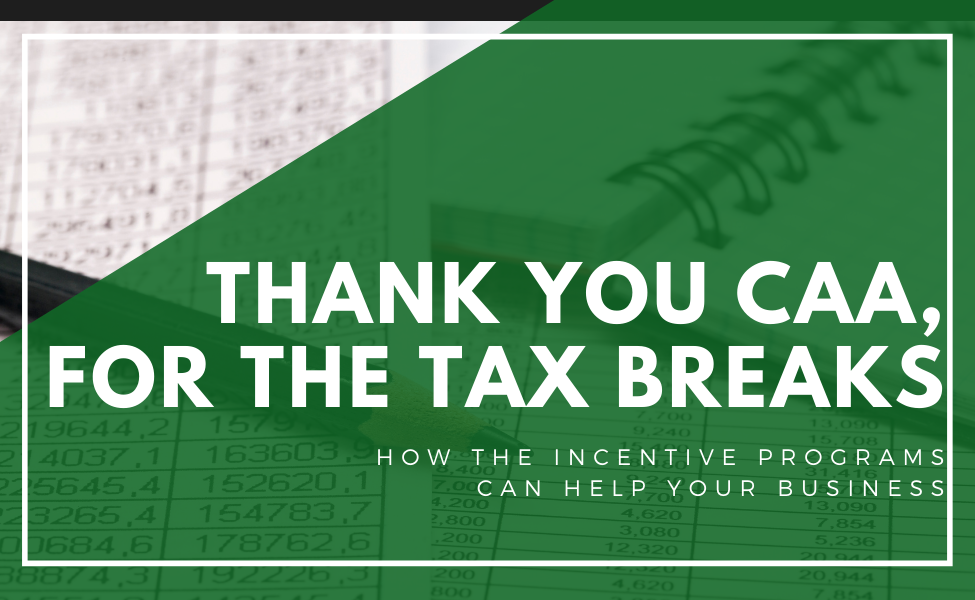The Consolidated Appropriations Act (CAA), what it means for your business

Tax Breaks and Credits starting this tax year!
The Consolidated Appropriations Act (CAA) was signed into law on December 27, 2020. The legislation adds a few new federal income tax breaks for businesses and extends a pack of other business breaks that were set to expire at the end of 2020.
(Yay!) Who doesn’t need a little assistance after the year that must not be named.
Here is what you need to know as a Small Business Owner.
Note from Self: I really don’t like the term Small Business. There is no such thing as a small business, not for us or our clients.
The tax changes explained in the Taxpayer Certainty and Disaster Tax Relief Act of 2020 (TCDTRA) and the COVID-Related Tax Relief Act of 2020 (COVIDTRA) are both included in The CAA which is 5,593 pages. Luckily, you don’t have to read it all. Nevertheless, these are some tax breaks and incentive programs for your business covered here. So, by all means read on!
100% Deductions for Business Meals Provided by Restaurants
Under the new law, you may deduct 100 percent of the cost of business-related food and beverages provided by restaurants in 2021 and 2022.
This applies equally to take-out and sit-down meals. In the past, you could generally deduct only 50% of the cost of business meals. Particularly, the 100% deduction rule is intended to help restaurants survive COVID-19 economic fallout. Let’s go out an help fellow business owners by having your next meeting be a lunch meeting.
Supporting local business, is absolutely the best way to help stimulate the economy.
Work Opportunity Credit Extended for Five Years
Your business can claim the work opportunity tax credit (WOTC) for hiring members of 10 targeted groups. Before the CAA, the WOTC only applied first year wages paid to qualifying employees who were hired before 2021.
New law. The TCDTRA extends the WOTC to cover first-year wages you pay to qualifying employees hired through 2025.

Who is a qualified employee you ask?
- Qualified IV-A Recipients
- Qualified Veterans
- Ex-Felons
- Designated Community Residents
- Vocational Rehabilitation Referral
- Summer Youth Employee
- Supplemental Nutrition Assistance Program (SNAP) Recipients
- Supplemental Security Income (SSI) Recipients
- Long-Term Assistance Recipients
- Qualified Long-Term Unemployment Recipients
For more information on qualified employees click here #TargetedEmployees
New Markets Credit Extended for Five Years
New Markets is an incentive program meant, above all, to encourage growth in distressed communities. This program was set to end in 2020, it has now been extended for the next 5 years. Undoubtedly, this is an incredible opportunity for both corporations and individuals alike.
The credit equals 39 percent of a taxpayer’s capital investment in a qualified entity. In turn, the recipient entity must loan or invest substantially all of the capital in qualified businesses that operate in low-income communities.
New law. The TCDTRA extends $5 billion annual allocations to cover the dispensations made through 2025. The TCDTRA extends the carryover for tax payers to use unclaimed tax credits through 2030.
Some Empowerment Zone Breaks Extended for Five Years (Others Allowed to Expire)
You can claim special federal income tax incentives in empowerment zones. Empowerment zones, like New Market Credits focus growth in distressed communities. In these zones, taxpayers are eligible for several tax credits and incentives including:
- 20 percent wage credits
- Enhanced first-year depreciation deductions
- Tax-exempt bond financing
- Deferral of federal capital gains taxes.
Simplified: Qualified assets must be sold and subsequent the proceeds reinvested in other qualifying assets.
New law. The TCDTRA extends through 2025 the period, for which empowerment zone designations can remain in effect. This simply emphasizes, the importance of revitalizing these areas. Despite, the new law creating opportunities, it does however, allow for some portions of the previous law to expire. for instance, the new law terminates the enhanced first-year depreciation rules for property placed in service in tax years beginning in 2021 and beyond. The new law also removes the capital gains tax deferral for sales in tax years 2021 and beyond.
Subsequently, want to know if you or your business is located in an Empowerment Zone?
Click here: #EmpowermentZoneMap
Tax-Free Treatment for Employer Section 127 Plan Payments Toward Employee Student Loans

The CARES Act employer could pay their qualified employee student loans. The good news is, this is not income for the employee as well it is a tax deduction for the Employer. Between March 28, 2020, and December 31, 2020, the employer could pay up to $5,250 per employee toward principal and interest.
New law. The TCDTRA extends this break to cover qualifying student loan debt payments made under Section 127 plans through 2025. Indeed, it may be time to think about helping your employees out with their student loans.
(Now that’s what I call a Win-Win!)
Clarifying Tax Impact of CARES Act Loan Forgiveness 
The CARES Act granted loan repayment assistance to eligible EIDL recipients. Without a doubt, something was lost in translation, The COVIDTRA clarifies some of that.
- Federal-income-tax-free treatment applies to forgiven EIDLs
- And certain loan repayment assistance.
The CAA helped to define what these loan payments and forgiveness actually mean. Who is eligible for what, and how more money , if any, will be distributed.
Deduction for Energy-Efficient Commercial Buildings Made Permanent
Commercial building owners can claim deductions for energy-efficient improvements this includes:
- Lighting
- Heating
- Cooling
- Ventilation
- Hot water systems
- And to building envelopes.
The write-off equals $1.80 per square foot. Apart from this, there is another credit of $0.60 per square foot, if the entire building does not.
New law. The TCDTRA makes this deduction permanent and adds an inflation-adjustment feature for tax years beginning in 2021 and later.
Go ahead and Get Green!

Credit for Energy-Efficient Manufactured Homes Extended
Manufacturers of residential homes can claim a credit of $1,000 or $2,000 for homes that meet applicable energy-efficiency standards.
New law. In addition, The TCDTRA extends the credit to cover new homes that are acquired from manufacturers in 2021 for use as residences.
Looking to take advantage of the Real estate market and the low interest rates? Look into Energy-Efficient homes for additional tax credits this year!
More incentives for the Environment and how we can help ourselves by helping the planet!

Credit for Alternative-Fuel Vehicle Refueling Equipment Extended
Your business can claim a federal income tax credit for up to 30 percent of the cost of installing non-hydrogen alternative-fuel vehicle refueling equipment. Especially, if your business uses, for example, Tesla vehicles as a Fleet. Or more likely, for use by your employees who own electric vehicles.
I believe here the government would like you to pay your employees enough to afford a Tesla. With out a doubt, Tesla would! For that matter, any electric car will do.
New law. The TCDTRA extends this break to cover qualifying 2021 expenditures.
This could be the time for you yourself to look into that new electric car you may have had your eye on. Even so, I am not endorsing any electric car company, I just think they are cool!
Credit for Fuel Cell Vehicles Extended
Also, Your business can claim a federal income tax credit for buying vehicles propelled by chemically combining oxygen with hydrogen to create electricity. These are another form of alternative fuels. (I’ll admit, I had to look this one up. However, in my brief research I couldn’t more than one manufacture)
- The base credit is $4,000 for vehicles weighing 8,500 pounds or less.
- Heavier vehicles can qualify for bigger credits of up to $40,000.
- An additional $1,000 to $4,000 credit is available to cars and light trucks to the extent their fuel economy meets federal standards.
New law. The TCDTRA extends this break to cover qualifying 2021 purchases.
Over all this, bill is focusing on restaurants, student, and energy, the three main issues facing our economy and future.
Most importantly, I hope this article any all the rest have given you some insight into creating a better business!
It should be noted, there are more tax credits and incentive programs not included here. The CAA has just about something for every business. Although, it may not be as entertaining as reading War and Peace, this is not a piece of legislature that should be ignored. Obviously, I couldn’t cover it all. However, If you didn’t find something for your business in this article, here is a link to the entire CAA , use the find feature in the article, you may be happily surprised at what tax breaks have been designated for your industry.




